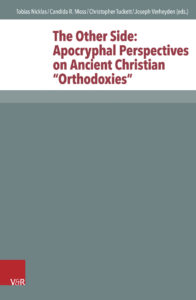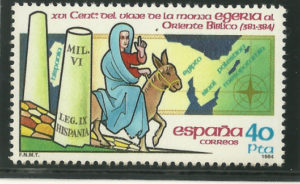Christian Apocrypha and Pilgrimage, Part 1
I have been asked to contribute an essay to the T&T Clark Handbook to Children and Childhood in the Biblical World, edited by Sharon Betsworth and Julie Faith Parker. Initially the editors asked me to write something on the Infancy Gospel of Thomas, given my previous work, but I feel that I have said everything I have to say (at least for the time being) on that text and its relationship to real or imagined children in antiquity. Instead I proposed a piece on “Travelling with Children: Flight Stories and Pilgrimage Routes in the Apocryphal Infancy Gospels.” I finished up the paper last week and thought I would share a portion of it here.
 Scholars of Christian apocrypha have only begun to examine the intersection of pilgrimage and apocrypha. Tobias Nicklas’s recent essay (that fortuitously arrived just as I was writing this paper) “Beyond ‘Canon’: Christian Apocrypha and Pilgrimage” (pages 23–38 in The Other Side: Apocryphal Perspectives on Ancient Christian “Orthodoxies,” ed. Tobias Nicklas et al. [NTOA 117; Göttingen: Vandenhoek & Ruprecht, 2017) is the first wideranging look at the apocryphal traditions that appear in the early pilgrimage itineraries. These itineraries, composed between the fourth and the seventh centuries, all focus on Palestine, though a few of the pilgrims travel further afield to Sinai and Egypt. References in them to locations from noncanonical texts and traditions include the Piacenza Pilgrim’s mention of a synagogue in Nazareth where he saw “the book in which the Lord wrote his ABC” (an allusion to Infancy Gospel of Thomas 6 and 14) and a bench that Jesus and other children sat upon that cannot be moved (Plac. Itin. 5). The pilgrim also visited Scythopolis, where miracles were performed by John the Baptist (Plac. Itin. 8), and saw the cross of St. Peter housed in the Basilica of St. Zion (Plac. Itin. 22; related, albeit loosely, to the various martyrdom accounts of Peter), and a field in Jericho “which the Lord sowed with his own hand. Its yield is three pecks, and it is reaped twice a year, but it grows naturally, and is never sown. They reap it in February, and then use the harvest for Communion at Easter. After this harvest, they plough, and the next reaping is at the time of other harvesting, after which it is ploughed and left fallow” (Plac. Itin. 13; an allusion perhaps to Inf. Gos. Thom. 12, but associated by Nicklas with P. Egerton 2). The field is mentioned also twice by Theodosius (1 and 18) along with Sinope as the location for the Acts of Andrew and Matthias (13), and the Ecclesia Kathismatis, a church built in the mid fifth century to commemorate where Mary dismounted from her donkey on the way from Jerusalem to Bethlehem (28; cf. Protevangelium of James 17:3).
Scholars of Christian apocrypha have only begun to examine the intersection of pilgrimage and apocrypha. Tobias Nicklas’s recent essay (that fortuitously arrived just as I was writing this paper) “Beyond ‘Canon’: Christian Apocrypha and Pilgrimage” (pages 23–38 in The Other Side: Apocryphal Perspectives on Ancient Christian “Orthodoxies,” ed. Tobias Nicklas et al. [NTOA 117; Göttingen: Vandenhoek & Ruprecht, 2017) is the first wideranging look at the apocryphal traditions that appear in the early pilgrimage itineraries. These itineraries, composed between the fourth and the seventh centuries, all focus on Palestine, though a few of the pilgrims travel further afield to Sinai and Egypt. References in them to locations from noncanonical texts and traditions include the Piacenza Pilgrim’s mention of a synagogue in Nazareth where he saw “the book in which the Lord wrote his ABC” (an allusion to Infancy Gospel of Thomas 6 and 14) and a bench that Jesus and other children sat upon that cannot be moved (Plac. Itin. 5). The pilgrim also visited Scythopolis, where miracles were performed by John the Baptist (Plac. Itin. 8), and saw the cross of St. Peter housed in the Basilica of St. Zion (Plac. Itin. 22; related, albeit loosely, to the various martyrdom accounts of Peter), and a field in Jericho “which the Lord sowed with his own hand. Its yield is three pecks, and it is reaped twice a year, but it grows naturally, and is never sown. They reap it in February, and then use the harvest for Communion at Easter. After this harvest, they plough, and the next reaping is at the time of other harvesting, after which it is ploughed and left fallow” (Plac. Itin. 13; an allusion perhaps to Inf. Gos. Thom. 12, but associated by Nicklas with P. Egerton 2). The field is mentioned also twice by Theodosius (1 and 18) along with Sinope as the location for the Acts of Andrew and Matthias (13), and the Ecclesia Kathismatis, a church built in the mid fifth century to commemorate where Mary dismounted from her donkey on the way from Jerusalem to Bethlehem (28; cf. Protevangelium of James 17:3).

As for locations in Egypt, Piacenza visited the place where Mary rested on the flight to Egypt (Plac. Itin. 28; cf. perhaps related to Gospel of Pseudo-Matthew 20–21) and mentions an otherwise unknown tradition about the Holy Family’s stay in Memphis: “In Memphis was the temple (now a church) which had a door which shut in the Lord’s face when he visited it with Blessed Mary, and until this day it cannot be opened. We saw there a piece of linen on which is a portrait of the Saviour. People say he once wiped his face with it, and that the outline remained. It is venerated at various times and we also venerated it, but it was too bright for us to concentrate on it since, as you went on concentrating, it changed before your eyes” (Plac. Itin. 44).
Nicklas’s narrow focus on the pilgrim itineraries leaves neglected several other sites associated with apocryphal texts and traditions, including the Eleona Church, which is built over a cave on the Mount of Olives where Jesus appeared to John (cf. Acts of John 97), the Cave of the Nativity (cf. Prot. Jas. 18:1) known to Jerome (Epist. 57.3; cf. Justin, Dial. 78), the Tomb of the Virgin (cf. the various Dormition of the Virgin texts), and Ain Karim, where Elizabeth and John the Baptist are said to have hidden from Herod’s soldiers (cf. Prot. Jas. 22:3 but explicitly identified in Life of John the Baptist by Serapion 3:9). Several more are listed in John Wilkinson’s Jerusalem Pilgrims before the Crusades (Warminster: Aris & Phillips, 1977, p. 41 n. 140), but no sources are provided: Mary’s Nativity at the Sheep Pool, her Falling Asleep on Sion, Diocaesarea as the scene of her childhood, Tabgha as the scene of the apostles’ baptism, and Choziba as the place where Mary’s birth was announced to Joachim.
The pilgrims of Nicklas’s study also do not journey to the sites in Rome that commemorate the martyrdoms of Peter and Paul (for these see David L. Eastman, Paul the Martyr: The Cult of the Apostle in the Latin West. WGRWSup 4. Atlanta: Society of Biblical Literature; Leiden: Brill, 2011), and even those who do make it to Egypt seem to be unaware of sites described in a selection of apocryphal texts that expand upon the Holy Family’s Flight to Egypt as told in Matthew 2:13–15 and 19–21. These texts will be discussed in Christian Apocrypha and Pilgrimage part 2.
